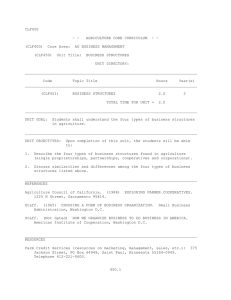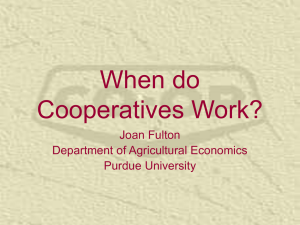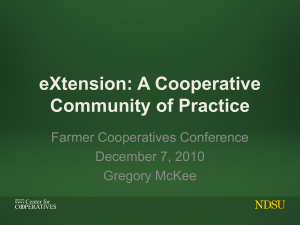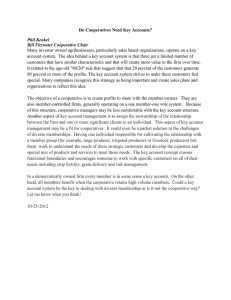WORKERS COOPERATIVES 1. Introduction
advertisement
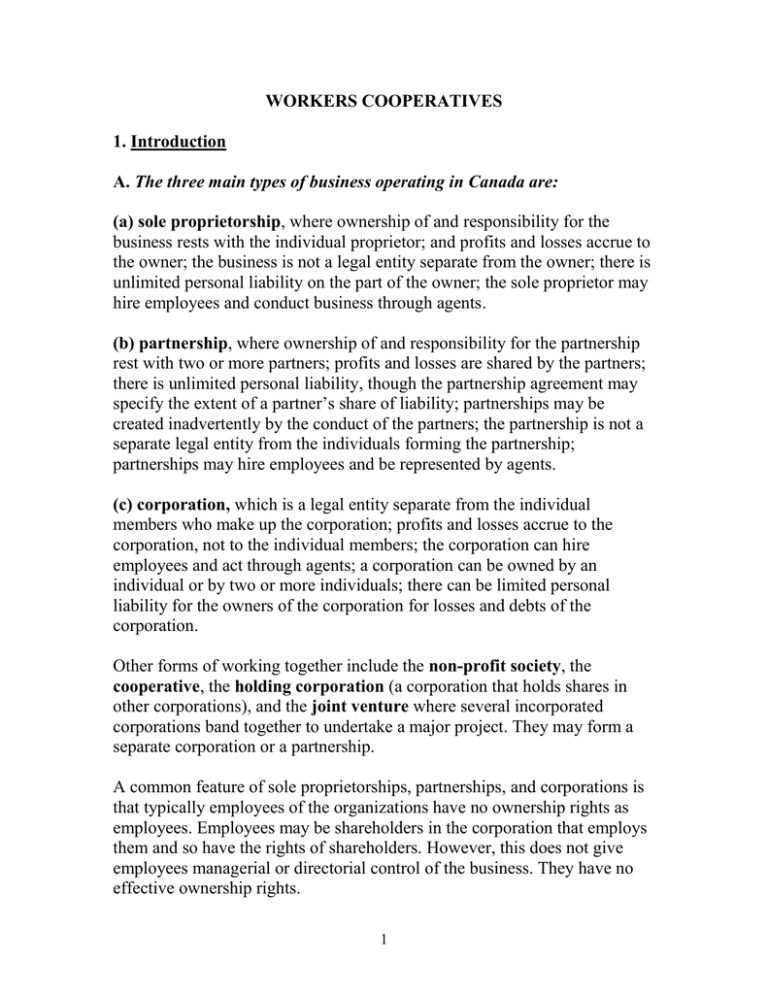
WORKERS COOPERATIVES 1. Introduction A. The three main types of business operating in Canada are: (a) sole proprietorship, where ownership of and responsibility for the business rests with the individual proprietor; and profits and losses accrue to the owner; the business is not a legal entity separate from the owner; there is unlimited personal liability on the part of the owner; the sole proprietor may hire employees and conduct business through agents. (b) partnership, where ownership of and responsibility for the partnership rest with two or more partners; profits and losses are shared by the partners; there is unlimited personal liability, though the partnership agreement may specify the extent of a partner’s share of liability; partnerships may be created inadvertently by the conduct of the partners; the partnership is not a separate legal entity from the individuals forming the partnership; partnerships may hire employees and be represented by agents. (c) corporation, which is a legal entity separate from the individual members who make up the corporation; profits and losses accrue to the corporation, not to the individual members; the corporation can hire employees and act through agents; a corporation can be owned by an individual or by two or more individuals; there can be limited personal liability for the owners of the corporation for losses and debts of the corporation. Other forms of working together include the non-profit society, the cooperative, the holding corporation (a corporation that holds shares in other corporations), and the joint venture where several incorporated corporations band together to undertake a major project. They may form a separate corporation or a partnership. A common feature of sole proprietorships, partnerships, and corporations is that typically employees of the organizations have no ownership rights as employees. Employees may be shareholders in the corporation that employs them and so have the rights of shareholders. However, this does not give employees managerial or directorial control of the business. They have no effective ownership rights. 1 B. Difficulties for employees If the labour market experiences a shortage of labour, employees can benefit from relatively high wages. However, under capitalism, workers appear to be under constant pressure from corporate and government policies designed to reduce labour costs. Historically, a variety of devices have been used by employers to reduce labour costs, including replacing labour with automation, machinery, breaking down complex skilled work into lowskilled tasks, importation of low-skilled, low-wage labour, contracting out work to companies that use low-skilled, cheap labour, moving business operations to low-wage countries, increasing the intensity of work to demand more output and effort for the same pay, and resisting the creation of trade unions or, as in Argentina at present, workers cooperatives. Today, western governments generally support low-wage policies by facilitating the movement of labour and capital across national boundaries. Increased “free trade” and the reduction or elimination of tariff barriers allows low wage countries to sell their products at lower prices in western countries, thus undermining the viability of domestic enterprises. The difficulty for employees and their lack of rights of ownership of the enterprise that employs them, is that they lack the power to decide or control what level of profit is acceptable, the level of wages and benefits paid, the technology used, whether the enterprise will cease operations or move to another location, whether the enterprise will declare bankruptcy and so on. By having no control over whether an enterprise will remain active in the community in which they live, employees are also vulnerable to the risk or hardship of the economic and social collapse of their community if their employer is a major one, and decides to move its production or service enterprises elsewhere, in the interest of higher profits. The serious economic and social impact of the flight of major corporations from communities is illustrated by General Motors’ flight from Flint, Michigan in the 1990s. Workers were unable to resist the “downsizing” and eventual closure of Buick plants. Indeed, the United Auto Workers (UAW) tended to thwart workers’ resistance. The flight of capital and business from Argentina in the 1990s also left workers in dire straits. Such flights of capital are generally justified by appeal to efficiency, competitiveness, and profitability. However, such measures only represent some of the indicators 2 of societal wellbeing and progress. If other measures of societal wellbeing are used, profit and efficiency tell a highly distorted tale. For example, the depletion of natural resources is not counted in the balance sheet of corporations or in measures of gross domestic product (GDP). Pollution and its negative impact on health, reduced leisure time, income distribution, reduced lifespan of consumer durable products and so on are excluded from corporate and government accounting, giving the illusion of greater wellbeing and progress than is actually delivered by capitalism (see Halstead and Cobb on Library Reserve for more realistic measures of wellbeing and progress). While cooperatives are not the most common form of business entity, provincial legislation governs them in each Canadian province. In Alberta, the legislation is the Cooperatives Act, R.S.A. Chapter C-28.1. The types of cooperatives provided by the legislation are: (i) housing; (ii) employment; (iii) multi-stakeholder; and (iv) new generation. In the modern era, worker and consumer cooperatives began in Rochdale, England in the 19 th Century. They remain there and in Canada as agricultural producer co-ops, consumer co-ops, credit unions, and workers’ co-ops, housing co-ops and others. 2. Mondragon Robert Gilman in Mondragon: the Remarkable Achievement asks “what is the Mondragón story, and why is it so important?” Its roots go back at least into the Spanish Civil War, but we can begin in 1941 when a young Basque priest, Father Jose Maria Arizmendiaretta (Arizmendi) came to Mondragón. Arizmendi, like most Basques, had fought on the losing republican side. He had been imprisoned as a POW and, after his release, had entered the church. His bishop had sent him to Mondragón with the charge of tending to the young, and he began his work by teaching in the apprentice school of the Union Cerrajera, the main industrial company in town. He soon found this too limiting, and by 1943 he had opened a technical training school with the support of the townspeople. In this school, he provided his students with not only a good technical education, but also a sophisticated understanding of Catholic Social Doctrine with its emphasis on cooperation and "the primacy of labour among the factors of production". 3 After continuing their education, a number of his students tried, but without success, to apply his teachings within the traditional companies where they had found work. By 1954, five of his original 11 decided to form a new company (ULGOR) where they could implement these teachings, and by 1956, after raising funds from local townspeople, they opened their factory with 24 worker-members. Twenty-six years later, in 1982, the Mondragón Cooperative Movement had 20,000 worker-members, 85 industrial cooperatives (producing everything from machine tools to refrigerators to electronic equipment), 6 agricultural cooperatives, 2 service cooperatives, 43 cooperative schools, 14 housing cooperatives, a large consumer/worker cooperative with over forty stores, plus four second level cooperatives that provide services to the primary cooperatives. These four are a bank (Caja Laboral Popular) with 120 branch offices, a technological research institute (Ikerlan), the League of Education and Culture (including a Polytechnical College, a Business School and a Professional College), and a social security and medical cooperative (Lagun-Aro). During this remarkable growth they have had only one failure - a fishing cooperative. At the end of 2003, the Mondragon Cooperative had 68,260 employee members in 218 companies of which around half were cooperatives. Combined assets of 16.3 billion euros, 3.3 billion profits and total sales of 9.6 billion euros (2.5 billion international). Around half of total employees are co-op members – mainly those in the Basque Region. There are two reasons for this proportion. Some workers are only temporary non-members, and in many countries into which MCC has ventures, there is no cooperative legislation. The MCC is currently reviewing policy on the issue of membership. This matter appears to confirm the difficulties that attend rapid growth. To appreciate these statistics, it helps to see them against the usual success rates for both new small businesses and producer cooperatives in general, neither of which has been very impressive. For example, in America 80 to 90 percent of new small businesses fail within 5 years. The situation with producer-cooperatives, which have been tried in various forms since the middle of the 19th century, is more complex, but basically most have either failed through poor management or succeeded as businesses only to be bought out after a short cooperative life. 4 What makes the Mondragón movement so effective? Gilman suggests three key elements: (http://www.context.org/ICLIB/IC02/Gilman2.htm) 1) The cultural and economic condition of the Basque region; 2) The specific pattern of rights and responsibilities of workermembers; 3) The supporting institutions they have developed, particularly their bank. The Basques are a proud, industrious, thrifty, and socially cohesive people with strong nationalist ambitions. The Spanish Civil War left their economy devastated and left them politically under the control of a vengeful, repressive and suspicious central government. These conditions seem to have been a great help in focusing Basque energy into the Mondragón movement since it provided a means of rebuilding their economy and expressing the strength of their community in a way that was not seen as politically threatening. Whether or not Mondragón type businesses could function as well in a less socially cohesive setting is currently an unanswered question. The financial and organizational structure of these cooperatives is, in significant details, different from many of the less successful British and American attempts. The essential features of their system are as follows: 1) All employees and only employees are members, with a one person one vote control of the Board of Directors (all of whom must also be worker-members). 2) The Board of Directors selects the top management, which then functions in a more or less conventional way. However, the general membership also independently elects a Watchdog Council to monitor the financial performance of the cooperative and a Social Council which deals with a wide range of personnel affairs and makes binding decisions on safety, pay scale, and social welfare. 3) All new worker-members must contribute (over two years) around $5000 to the capital of the cooperative. While this may seem like a large sum, it is still only about 10% of the capital cost of creating the new job, and 5 it emphasizes the seriousness with which they take their role as owners as well as workers. It can be paid in installments from wages. 4) To insure a sense of equality and solidarity among all the workermembers, they restrict the range of highest pay to lowest pay to an effective ratio of 6 to 1. (Once 3 to 1). In practice this means that the lowest paid earn more than comparable workers in ordinary companies, while the executives earn less than their capitalist peers. Those managers who have grown up within the system seem to appreciate the non-monetary rewards, but this rule has so far prevented the establishment of a cooperative hospital. (The doctors aren't willing to lower their pay scale.) 5) Only part of the cooperative's earnings are paid out as immediate "wages", while the rest are retained in internal capital accounts that are assigned to each worker but available to them only when they retire. They have done this in a way that allows each worker to benefit from the equity value of his or her ownership, but does not threaten the integrity of the cooperative. Unlike ordinary corporate shares, these internal accounts cannot be sold and they carry no voting rights. There is some criticism that insufficient money is paid into personal capital accounts and too much into reserves, which are collectively owned but not accessible by individual members. The second level cooperatives, for example the bank, have a slightly different structure. As usual, all workers are members, but the other cooperatives are also considered members. (Unlike credit unions and mutual savings banks, depositors are not members.) The Board of Directors is made up of representatives from the other cooperatives (2/3) as well as worker- members of the bank (1/3). Aside from this broader definition of membership, the internal structure of the second level cooperatives is similar to that of the others. The bank has two main divisions, the Banking Division and the “Empresarial Division”. The Banking Division provides normal banking service to its 1/2 million customers through 120 branch offices. It also serves as a major source of new capital for the first level cooperatives. The unique feature of the bank, however, is the “Empresarial Division”, whose basic function is to aid in the creation of new cooperatives and provide management assistance to the existing 6 ones, especially when they are making any major changes such as entering a new market or launching a new product. The following list of departments give some idea of the scope that the staffmembers of this division cover: Research, Library and Documentation Center, Agricultural/Food, Industrial Products, Industrial Promotion and Intervention, Export, Marketing, Productions, Personnel, AdministrativeFinancial, Legal, Auditing, Information and Control, Urban Planning, Industrial Building, and Housing. The Bank also serves as the hub of the whole Mondragón Cooperative Movement. Each cooperative runs itself through its own Board of Directors, but they are all linked to the bank (and each other) through a "Contract of Association". This contract grants the cooperative membership rights in the bank, and spells out the basic principles the cooperative must follow to be part of the Mondragón movement. There are also special relationships worked out between cooperatives in related areas so that they can work together like the divisions of a larger company. The MCC attributes its success to six key points: (See http://www.mondragon.mcc.es/ing/contacto/faqs.html#) (a) the vision of its founder father Jose Maria Arizmediarreta, with his emphasis on youth, education and training and the Catholic doctrine of the primacy of labour over capital; (b) the participation of workers in management, and in the investment of capital, as motivation; (c) planned, rigorous attention to efficiency, and profitability on the part of management; (d) reinvestment of practically all profits generated; (e) co-operation among the different enterprises on matters of finance and social welfare; 7 (f) education, training and lifelong learning within the cooperatives; MCC has a university accessible to any student with the academic admission qualifications. The advantages of cooperative membership appear to be higher wages, better pensions, and more secure employment for non-managerial workers, than that available to comparable workers in the community. Greater security arises from the lesser risk of redundancy due to flight of capital as with regular corporations. Managers tend to be paid less than their counterparts in the capitalist system. MCC does not see cooperatives as an alternative to capitalism but rather as a form of organization that benefits from modern theories of management and motivation of employees. There are inevitable tradeoffs. In order to increase job security and long-term income security, workers in the co-ops may have to sacrifice short-term earnings. While worker participation in management carries benefits of an effective voice, it requires action by individual workers. The co-ops’ attachment to their respective communities encourages action by the co-op to contribute to the economic and cultural health of the community. Such contributions are not just monetary but the creation of educational, social and cultural organizations within their communities. The MCC also believes its form of organization resolves the industrial conflict traditionally associate with collective and individual employee/management relations. 8
